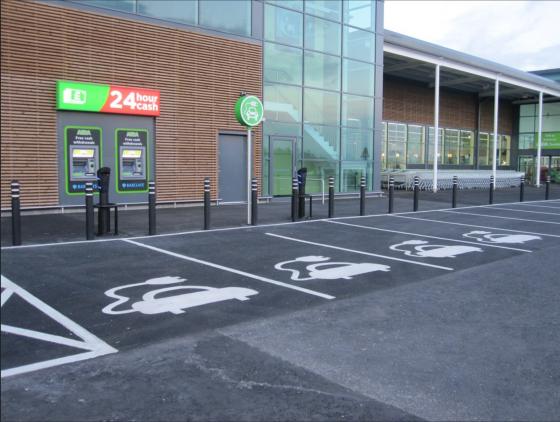Green Building Community
Jumpstarting The EV Transition
Posted by: gracemorrison

This year might just be pivotal in the growth of electric vehicle adoption, a key shift necessary to lower vehicle energy consumption and emissions, as a part of the larger fight to mitigate the effects of climate change and preserve environmental health. EV demand was already growing with the number of electric cars on the road doubling between 2020 and 2021, and then this year, owning an electric vehicle became even more desirable. As of May 2022, Ford EV sales increased by 139% and Volkswagen by 65%, with an overall increase of 81% (Cohen, 2022).
Key factors to this discussion include higher gas prices, EV infrastructure, government incentives and subsidies, public EV fleets, and the financial and environmental benefits.
Higher Gas Prices
Russia's unjust war on Ukraine has been all over the news and has resulted in the highest gas prices in US history, surpassing $5, with the highest previously recorded being July of 2008 at $4.114 (Saul, 2022). The issues these gas prices raise may seem temporary, with the US gas industry claiming that producing more gas is the solution; however, an influx of production in the US won't change gas prices because the global market sets these prices, not the US. The world has become overly dependent on fossil fuels but now bears witness to an opportunity for environmental change that is financially beneficial. Dependence on gas leaves countries vulnerable to the volatile global market; reliance on fossil fuel producers leaves markets subject to the actions and aggression of these producers. High gas prices will always be unstable because they have nothing to do with individual national production. Gas prices aren't independent of the global market, so the only solution is to move away from fossil fuels and toward energy and economic independence. Any fuel producer's aggression can lead to market instability; this instance is not an independent issue. Owning an electric vehicle has always been a good investment and is now more essential than ever.
Electric Vehicle Infrastructure
The electric vehicle is becoming far more common and convenient with charging stations increasing in number and charging at these stations is much cheaper than pumping gas. Because there are multiple sources of this electricity, the insecure global market has less influence on its price; research shows an EV driver saves $800 to $1000 on fuel annually (Lindwall, 2022). Additionally, while now fossil fuels generate some of this electricity, EVs are poised to be receptive to the renewable energy transition; the source of the electricity does not affect the vehicle, meaning an EV can operate on entirely renewable energy.
Furthermore, anyone who takes their car to cities such as Boston has probably faced the common problem of no parking or gas stations. However, for an example of EV convenience, Boston now has EV-only parking lots and EV-charging stations. These improvements, in addition to Massachusetts’ rebates and tax credits, are an example of state incentives to buy an EV in addition to the sweeping motivation of gas price insecurity.
Additionally, the Department of Transportation has proposed more federally funded charging stations across the country for convenience and to encourage electric vehicle usage. Much of the fear of buying an EV is the inconsistency of charging stations, but this proposal can alleviate this issue. In this new provision, states will receive $7.5 billion to develop and standardize charging stations, improving infrastructure to reflect the necessity of EVs and their emission reduction.
With the growing popularity of EVs, the increased demand is causing issues in the supply chain. EV batteries require lithium, a resource of which there is a shortage in the US. This shortage is raising prices in EVs, but the Biden Administration has committed $3.1 billion to fund US battery production and the White House hopes to encourage EV sales to account for over half of vehicle sales by 2030.
Incentives and Subsidies
The federal government offers a tax credit of up to $7500 to encourage the transition to electrification, lowering emissions and air pollution. The tax credit’s applicability is different for EV manufacturers, here you can see the current standing of EV models: https://www.edmunds.com/fuel-economy/the-ins-and-outs-of-electric-vehicle-tax-credits.html
Here you can read about the rebates and incentives by state: https://afdc.energy.gov/laws/recent
Growing Public Fleets
Some cities have switched to EV public transport, a transition that reduces operating costs and improves air quality. The city of Pune in India has employed electric buses in public transportation which are not only reportedly quieter and cleaner but reduce particulate matter and carbon emissions. Pune utilizes incentives for e-busses, ultimately reducing operating costs to be cheaper than diesel buses. This e-bus transition improves health by reducing pollutants and encourages further EV progression, with Pune witnessing an increase in EV registration, as 10% of vehicles registered in March of 2022 were EVs (RMI India, 2022). This successful example should act as a model for public transport in other cities.
Moreover, New York has committed to transitioning to electric school buses by 2035, improving the air quality and child health. While much of the current electricity powering these vehicles originates from fossil fuels, the emissions no longer pollute the air around these communities, which tend to disproportionately affect low-to-moderate income households and people of color due to their proximity to major roads. Although these electric busses currently operate primarily on fossil fuel electricity, the emissions per mile driven are lower for EVs, making them more efficient; electric school buses prepare communities for a renewable energy transition, reducing their climate impact. Employing electric vehicles wherever we can, reduces the emissions polluting the air we breathe while also being a worthy and cost-saving investment.
Benefits
In addition to the growing convenience of owning an electric vehicle, EVs have numerous other benefits as well. A factor to consider is that the maintenance expenses of gas-powered vehicles aren’t an issue in EVs; there’s no need for an oil change or engine check because an EV is essentially a computer that manufacturers fix remotely. Tailpipe emission standards, which will change as climate goals grow closer, will no longer be of concern. An EV is a wise investment that grows in profitability with such high gas prices and as states become more EV-friendly.
In addition to the convenience and financial benefits an EV provides, the environmental benefits of no combustion carbon emissions benefit the climate and our health. According to EDF Energy, “In over a year, just one electric car on the roads can save an average 1.5 million grams of CO2.” Electric cars help lower emissions and as a result, better our air quality which is beneficial to health.
Moreover, EVs are more viable than ever, and their implementation reduces emissions, improves air quality, and prepares people for the transition to renewable energy. EVs are a cheaper, more consistent, and environmentally conscious option, growing in popularity and convenience.
Progress Needed
Freight trucks, for example, produce 25% of greenhouse gas emissions, polluting our air. However, “65% of medium-duty and 49% of heavy-duty trucks are electrifiable today” (Rocky Mountain Institute, 2022) and can reduce emissions by 60% to 97%. Companies such as Amazon have committed to employing these electric trucks and as we look to the future, we can hope that many others follow suit.
While the upfront investment of buying any car can be expensive, looking to a specific state policy can reduce this cost with loans, rebates, and tax credits. The upfront cost is a profitable investment with a lack of maintenance and gas costs, leading to higher savings over the vehicle's lifetime. As EV technology develops, one gains access to upgrades by merely updating the computer that composes the vehicle. Buying an EV when it is financially viable is a wise investment in sustainability and a cost-saving option.
Further Reading on Misconceptions about EVs:
https://www.epa.gov/greenvehicles/electric-vehicle-myths
References:
- [image] Wallace, G. (2012), https://www.flickr.com/photos/inverness_trucker/7439909738
- Cohen, A. (2022, May 10). 2022: The Great Boom or Great Bust for Electric Vehicles. Retrieved from https://www.forbes.com/sites/arielcohen/2022/05/09/2022-the-great-boom-or-great-bust-for-electric-vehicles
- EDF. (n.d.). Benefits of electric cars on the environment. Retrieved from https://www.edfenergy.com/for-home/energywise/electric-cars-and-environment
- Huether, P. (2022). 9,000-Pound Electric Hummer Shows We Can’t Ignore Efficiency of EVs. Retrieved from https://www.aceee.org/blog-post/2022/06/9000-pound-electric-hummer-shows-we-cant-ignore-efficiency-evs
- Lindwall, C. (2022). Is Now a Good Time to Buy an Electric Car? Retrieved from https://www.nrdc.org/stories/now-good-time-buy-electric-car
- Mersky, A., & Rodeffer, M. (2022). Communities Look to Electric School Buses to Reduce Pollution. Retrieved from https://www.aceee.org/blog-post/2022/06/communities-look-electric-school-buses-reduce-pollution-improve-student-health
- Miller, K. (2022). DOT announces proposed rule for EV charging infrastructure | U.S. Green Building Council. Retrieved from https://www.usgbc.org/articles/dot-announces-proposed-rule-ev-charging-infrastructure
- RMI India. (2022, June 10). Transforming Urban Mobility. Retrieved from https://rmi.org/transforming-urban-mobility/
- Rocky Mountain Institute. (2022, May 9). Electric Trucks Reach a Tipping Point. Retrieved from https://rmi.org/press-release/electric-trucks-reach-a-tipping-point/
- Rosevear, J. (2022, May 2). Biden administration announces $3.1 billion to make electric vehicle batteries in the U.S. Retrieved from https://www.cnbc.com/2022/05/02/white-house-announces-3point1-billion-for-us-ev-battery-manufacturing-.html
- Saul, D. (2022, June 10). $5 Milestone: Gas Prices Hit An All-Time National High. Retrieved from https://www.forbes.com/sites/dereksaul/2022/06/09/5-milestone-gas-prices-hit-an-all-time-national-high
Please be kind and respectful!
Please make sure to be respectful of the organizations and companies, and other Rate It Green members that make up our community. We welcome praise and advice and even criticism but all posted content and ratings should be constructive in nature. For guidance on what constitutes suitable content on the Rate It Green site, please refer to the User Agreement and Site Rules.
The opinions, comments, ratings and all content posted by member on the Rate It Green website are the comments and opinions of the individual members who posts them only and do not necessarily reflect the views or policies or policies of Rate It Green. Rate It Green Team Members will monitor posted content for unsuitable content, but we also ask for the participation of community members in helping to keep the site a comfortable and open public forum of ideas. Please email all questions and concerns to admin@rateitgreen.com

